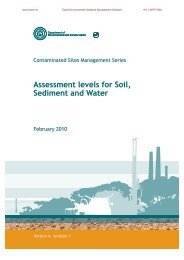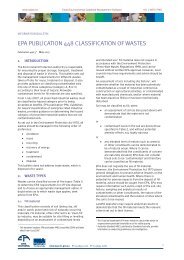Soil Generic Assessment Criteria for Human Health Risk ... - ESdat
Soil Generic Assessment Criteria for Human Health Risk ... - ESdat
Soil Generic Assessment Criteria for Human Health Risk ... - ESdat
You also want an ePaper? Increase the reach of your titles
YUMPU automatically turns print PDFs into web optimized ePapers that Google loves.
www.esdat.net Esdat Environmental Database Management Software +61 2 8875 7948<br />
3.5<br />
Derivation of GAC<br />
GAC were derived using the CLEA model v1.06. The recommended values from the pro<strong>for</strong>mas were transposed<br />
to the contaminant database in the CLEA model. A copy of the contaminant database used to derive the GAC<br />
is provided as a freely downloadable spreadsheet with this report. A summary of the contaminant database is<br />
provided in Appendix A. GAC were produced <strong>for</strong> those contaminants with recommended values <strong>for</strong> all the required<br />
parameters. Note that, with the exception of di-n-butyl phthalate (which has evidence of localised toxicological<br />
effects in the upper respiratory tract – see Section 3.7) the critical toxicity of all compounds is expected to be<br />
systemic. For this reason, where HCV were available <strong>for</strong> both the inhalation and oral routes of exposure, the<br />
combined GAC have been reported.<br />
The derived GAC and exposure contributions <strong>for</strong> each pathway calculated by CLEA v1.06 are presented in Tables<br />
4.1a to 4.4e. Note that the GAC have been rounded to two significant figures. The pathway exposure contributions<br />
have been reported to one decimal place and are intended to aid the risk assessor in determining the appropriateness<br />
of the GAC <strong>for</strong> the site-specific conceptual site model.<br />
Table 4.1a presents the GAC <strong>for</strong> the metals. As discussed in Section 3.4, it was considered beyond the scope of the<br />
project to collate and review plant concentration factors <strong>for</strong> the metals and there<strong>for</strong>e GAC have only been produced<br />
<strong>for</strong> land-uses that do not include plant uptake, i.e. the residential without homegrown produce and commercial<br />
land-uses. Note that the derived GAC <strong>for</strong> metals are not dependent on SOM.<br />
Tables 4.2a, 4.3a and 4.4a present the GAC <strong>for</strong> 32 organic contaminants assuming 1%, 2.5% and 6% SOM,<br />
respectively. These tables also present the estimated soil saturation concentration 3 <strong>for</strong> each contaminant (rounded<br />
to three significant figures). As discussed in the Environment Agency of England and Wales SR2 report, soil<br />
concentrations exceeding soil saturation may indicate the presence of non-aqueous phase liquid (NAPL) and this<br />
should be considered when assessing the risks to human health. The presence of NAPL could pose additional risks<br />
to human health that are not accounted <strong>for</strong> in the GAC, such as the inhalation of vapours arising from NAPL sources<br />
and direct contact with NAPL. Odours arising from NAPL may also be cause <strong>for</strong> concern.<br />
Methodology<br />
As discussed in Section 3.2, HCV were not always available <strong>for</strong> both the oral and inhalation pathways. Where<br />
this was the case and where considered appropriate the use of route-to-route extrapolation, whereby the HCV<br />
<strong>for</strong> the oral route is applied to inhalation exposures and vice versa, has been adopted. This has been done in the<br />
CLEA model by selecting “Y,Y,Y” <strong>for</strong> the recommended HCV in the contaminant database such that the estimated<br />
average daily exposures (including MDIs) <strong>for</strong> the oral, dermal and inhalation pathways are compared to this HCV<br />
to derive the GAC.<br />
3 The soil saturation concentration is the theoretical concentration at which soil vapour and/or pore water have become fully saturated. This can<br />
indicate that NAPL is likely to be present, but <strong>for</strong> contaminants that are strongly sorbed to soils (i.e. have high K oc<br />
) and that have a low aqueous solubility<br />
and vapour pressure, exceedence of the soil saturation concentration does not necessarily imply that NAPL is present.<br />
19








